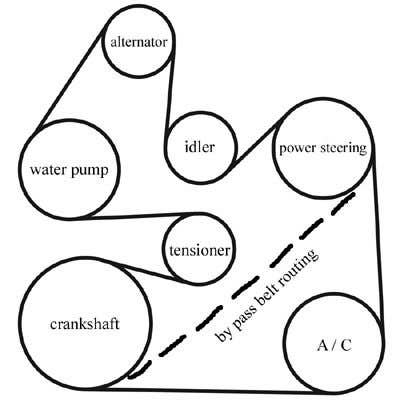Locating the correct serpentine belt routing for your 2002 Ford Taurus is critical for proper accessory function. This 3.0L V6 engine (VIN U) uses a 6-rib belt routed around specific pulleys.
2002 Ford Taurus Serpentine Belt Routing Diagram
Standing at the front of the vehicle, the belt path follows this sequence:
- Crankshaft Pulley (bottom center)
- Water Pump Pulley (right of crankshaft, rotates clockwise)
- Idler Pulley (top left, smooth surface)
- Alternator Pulley (top right, grooved)
- Power Steering Pump Pulley (left of alternator, grooved)
- Tensioner Pulley (bottom left, grooved)
Belt Specification: Use Motorcraft JK6-706 or equivalent (98.5" length, 6 ribs).

Replacement Procedure
Tools Needed: 1/2" drive breaker bar or serpentine belt tool, flashlight.
- Relieve tension by rotating tensioner clockwise using the square 1/2" drive hole.
- Slip old belt off pulleys while maintaining tensioner pressure.
- Verify all pulleys spin freely without grinding noises.
- Route new belt exactly as diagrammed above.
- Double-check all ribs seat fully in pulley grooves.
- Slowly release tensioner to engage belt.
Critical Mistakes to Avoid
- Incorrect Routing: Even one misrouted pulley causes immediate failure. Snap a photo before removal or use our written path.
- Damaged Belt: Never install belts showing cracks, fraying, or glazing. Flexing the belt 90 degrees should reveal no fractures.
- Improper Tensioning: Do not overtighten. The automatic tensioner maintains correct pressure; manual adjustment isn't required.
- Ignoring Pulley Alignment: Misaligned pulleys indicate worn mounts. Address before installation to prevent premature failure.
Final Tip: Start the engine and observe belt movement for at least 30 seconds. Listen for chirping (misalignment) or squealing (improper tension) before closing the hood.

